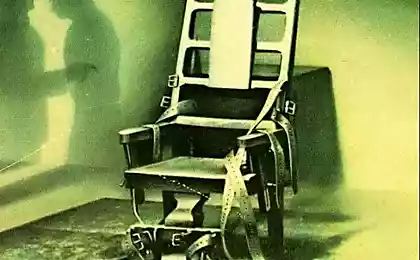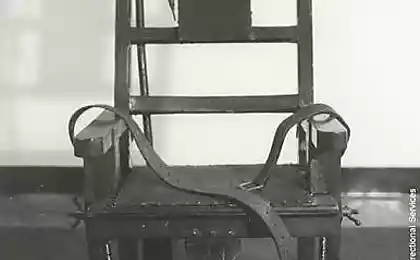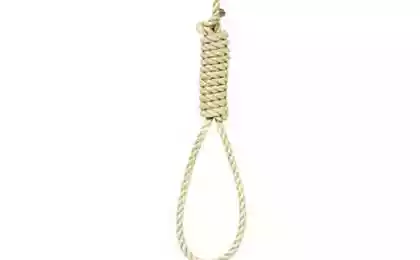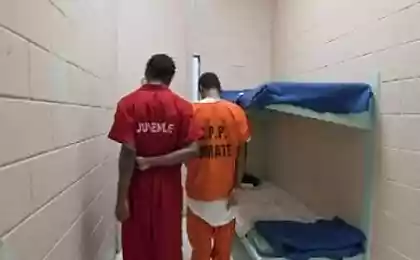931
Camye widespread executions of the ancient world
Mankind has long dealt harshly with his enemies, some of them even ate, but mostly they were executed, deprived of life a terrible way.
The same is done with criminals who violated the laws of God and man.
Over a thousand years of history have accumulated a lot of experience under sentence of execution.
Decapitation
The physical separation of the head from the body with an ax, or any military weapons (knives, swords) later for these purposes to use the machine, invented in France - Guillotine.
It is believed that with such a penalty the head separated from the body keeps eyes and ears still for 10 seconds. Decapitation was considered "noble execution" and applied to the aristocrats. In Germany, the beheading was abolished in 1949 because of the failure of the last guillotine.
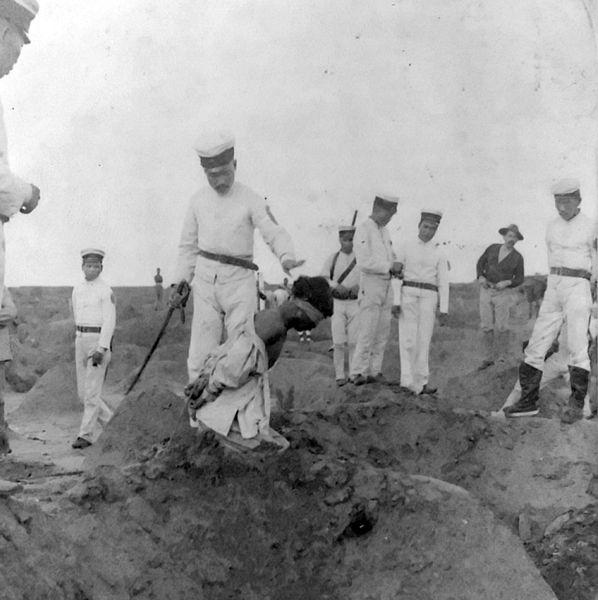
Hanging
Strangulation man on the rope loop end is fixed motionless, death occurs within a few minutes, but not by strangulation and by displacement of the carotid arteries, while in a few seconds the person loses consciousness and later dies.
In England, used a variety of hanging when dropped from a height of a man with a noose around his neck, with the death occurs instantly of a broken neck vertebrae.
In England, there was the "official table downs" with the help of which, calculated the required length of rope, depending on the weight of the convicted person, while too long a rope separates the head from the body.
A variety of hanging a - garrotte.
At the same man seated on a chair and hangman rope loop and a metal bar the victim suffocates.
Last loud hanging - Saddam Hussein.

Quartering
It is considered one of the most brutal killings, and applies to the most dangerous criminals.
When the victim pridushali quartering, then ripped open his stomach and genitals cut off and only then dissected the body into four or more parts, and cut off his head.
Thomas More, who was sentenced to be quartered with the insides burning, but in the morning before the execution was pardoned and quartering was replaced by decapitation, to which Moore replied: "God forbid my friends from such grace»
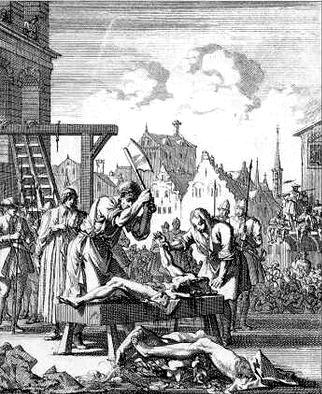
The wheel
Common in the Middle Ages the death penalty. Professor AF Kistyakovsky in the XIX century described the process is broken on the wheel, used in Russia:
Tied to the scaffold horizontally St. Andrew's cross, made of two logs.
On each of the branches of the cross made two recesses, the distance from one another on one foot.
This cross stretched offender so that the person he was converted to the sky; each extremity of it lay on one of the branches of the cross, and in every place every joint he was tied to the cross.
Then the executioner, armed with iron quadrilateral scrap strikes at part of the member between the joint, which is just lying on the recess.
This method breaks the bone of each member in two locations.
The operation ended in two or three blows to the stomach and Quitting backbone.
Break so the offender placed on a horizontally supplied wheel so that the heel came together from the back of the head, and left him to die in such a position.
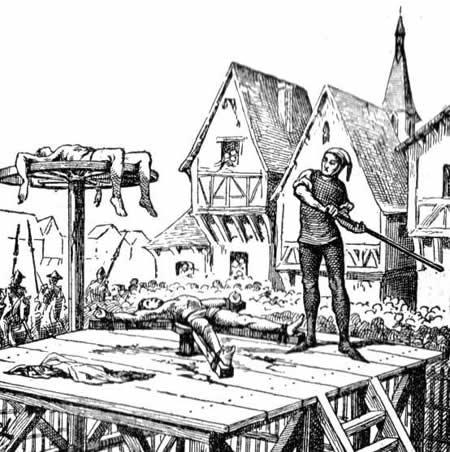
Burning at the stake
The death penalty, in which the victim is burned at the stake in public.
Execution is widespread in the period of the Holy Inquisition, and it was only in Spain ssozheno about 32 thousand people.
The execution took place on the one hand, without the shedding of blood, and fire and rescue facilitated purification of the soul, which is suited to the inquisitors for exorcism.
In fairness, it should be said that the Inquisition by witches and heretics filled up "budget", burning, usually the most affluent citizens.
The most famous people burned at the stake Dzhordzhano Bruno - as a heretic (engaged in scientific activities) and Joan of Arc, who commanded the French troops in the Hundred Years War.
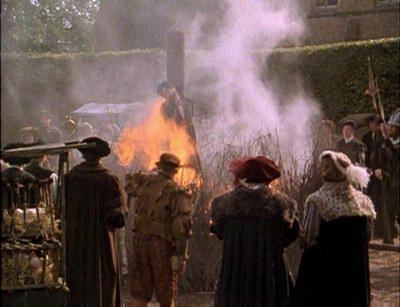
Impalement
The death penalty, in which the convicted person seated on a tapered vertical count.
Impalement was used in the Commonwealth until the 18th century, and many Zaporozhye Cossacks were executed in this way.
Also, this penalty is applied in Europe, particularly in Sweden in the 17th century.
Death occurs as a result of bleeding or peritonitis, the person dying slowly and painfully for several days.
For women, this penalty is applied in Romania, and the number inserted into the vagina, with death came quickly from excessive bleeding.
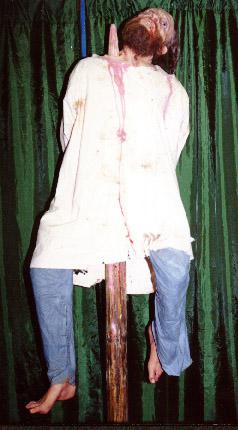
Hanging over the edge
Type of death, in which the victim stabbed in the side with an iron hook and hung.
Death occurs from thirst and loss of blood a few days.
The victim's hands bound, he was unable to free yourself.
The execution was common in the Zaporozhye Cossacks.
According to legend, in this way was executed Dmitry Vishnevetskii founder of the Zaporizhzhya Sich, the legendary "Baida Veshnivetsky."
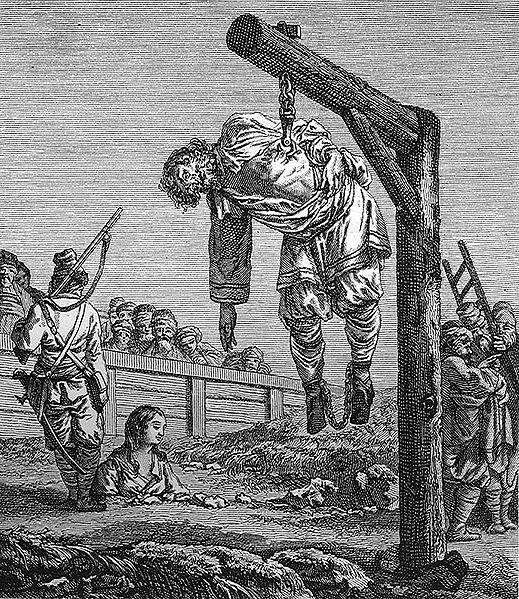
Throwing predators
A common view of the ancient penalty distributed among many peoples of the world. Death occurs because you ate crocodiles, lions, bears, sharks, piranhas, ants.
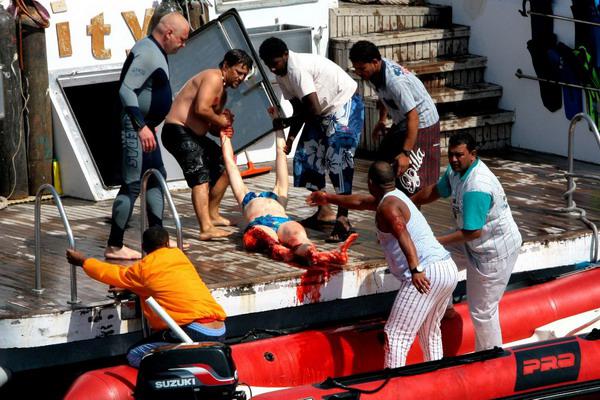
Buried
Buried applied to many Christian martyrs. In medieval Italy were buried alive unrepentant murderers.
In Russia XVII-XVIII century, buried alive up to her neck women who killed their husbands.
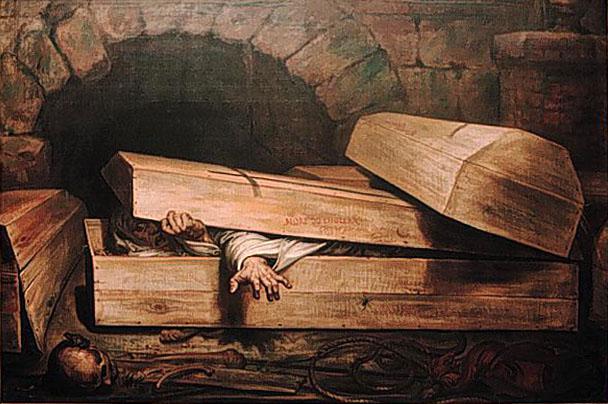
Crucifixion
Sentenced to death nailed hands and feet to the ends of the cross or the fixed end using cords. This is how Jesus Christ was put to death.
The main cause of death in crucifixion is asphyxia due to developing pulmonary edema and fatigue involved in the process of breathing the intercostal muscles and the abdominal muscles.
The main pillar of the body in this position are the hands and breathing abdominal muscles and intercostal muscles were to lift the weight of the entire body, leading to their rapid exhaustion.
Also squeezing chest strained muscles of the shoulder girdle and chest causing fluid retention in the lungs and pulmonary edema.
Additional causes of death were dehydration and blood loss.
Jaroslav via
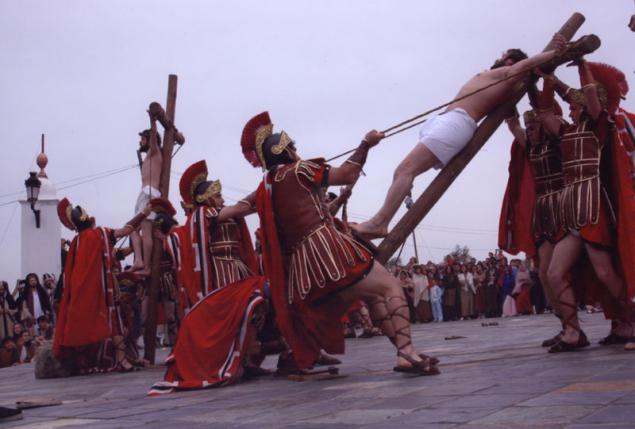
Source:
The same is done with criminals who violated the laws of God and man.
Over a thousand years of history have accumulated a lot of experience under sentence of execution.
Decapitation
The physical separation of the head from the body with an ax, or any military weapons (knives, swords) later for these purposes to use the machine, invented in France - Guillotine.
It is believed that with such a penalty the head separated from the body keeps eyes and ears still for 10 seconds. Decapitation was considered "noble execution" and applied to the aristocrats. In Germany, the beheading was abolished in 1949 because of the failure of the last guillotine.

Hanging
Strangulation man on the rope loop end is fixed motionless, death occurs within a few minutes, but not by strangulation and by displacement of the carotid arteries, while in a few seconds the person loses consciousness and later dies.
In England, used a variety of hanging when dropped from a height of a man with a noose around his neck, with the death occurs instantly of a broken neck vertebrae.
In England, there was the "official table downs" with the help of which, calculated the required length of rope, depending on the weight of the convicted person, while too long a rope separates the head from the body.
A variety of hanging a - garrotte.
At the same man seated on a chair and hangman rope loop and a metal bar the victim suffocates.
Last loud hanging - Saddam Hussein.

Quartering
It is considered one of the most brutal killings, and applies to the most dangerous criminals.
When the victim pridushali quartering, then ripped open his stomach and genitals cut off and only then dissected the body into four or more parts, and cut off his head.
Thomas More, who was sentenced to be quartered with the insides burning, but in the morning before the execution was pardoned and quartering was replaced by decapitation, to which Moore replied: "God forbid my friends from such grace»

The wheel
Common in the Middle Ages the death penalty. Professor AF Kistyakovsky in the XIX century described the process is broken on the wheel, used in Russia:
Tied to the scaffold horizontally St. Andrew's cross, made of two logs.
On each of the branches of the cross made two recesses, the distance from one another on one foot.
This cross stretched offender so that the person he was converted to the sky; each extremity of it lay on one of the branches of the cross, and in every place every joint he was tied to the cross.
Then the executioner, armed with iron quadrilateral scrap strikes at part of the member between the joint, which is just lying on the recess.
This method breaks the bone of each member in two locations.
The operation ended in two or three blows to the stomach and Quitting backbone.
Break so the offender placed on a horizontally supplied wheel so that the heel came together from the back of the head, and left him to die in such a position.

Burning at the stake
The death penalty, in which the victim is burned at the stake in public.
Execution is widespread in the period of the Holy Inquisition, and it was only in Spain ssozheno about 32 thousand people.
The execution took place on the one hand, without the shedding of blood, and fire and rescue facilitated purification of the soul, which is suited to the inquisitors for exorcism.
In fairness, it should be said that the Inquisition by witches and heretics filled up "budget", burning, usually the most affluent citizens.
The most famous people burned at the stake Dzhordzhano Bruno - as a heretic (engaged in scientific activities) and Joan of Arc, who commanded the French troops in the Hundred Years War.

Impalement
The death penalty, in which the convicted person seated on a tapered vertical count.
Impalement was used in the Commonwealth until the 18th century, and many Zaporozhye Cossacks were executed in this way.
Also, this penalty is applied in Europe, particularly in Sweden in the 17th century.
Death occurs as a result of bleeding or peritonitis, the person dying slowly and painfully for several days.
For women, this penalty is applied in Romania, and the number inserted into the vagina, with death came quickly from excessive bleeding.

Hanging over the edge
Type of death, in which the victim stabbed in the side with an iron hook and hung.
Death occurs from thirst and loss of blood a few days.
The victim's hands bound, he was unable to free yourself.
The execution was common in the Zaporozhye Cossacks.
According to legend, in this way was executed Dmitry Vishnevetskii founder of the Zaporizhzhya Sich, the legendary "Baida Veshnivetsky."

Throwing predators
A common view of the ancient penalty distributed among many peoples of the world. Death occurs because you ate crocodiles, lions, bears, sharks, piranhas, ants.

Buried
Buried applied to many Christian martyrs. In medieval Italy were buried alive unrepentant murderers.
In Russia XVII-XVIII century, buried alive up to her neck women who killed their husbands.

Crucifixion
Sentenced to death nailed hands and feet to the ends of the cross or the fixed end using cords. This is how Jesus Christ was put to death.
The main cause of death in crucifixion is asphyxia due to developing pulmonary edema and fatigue involved in the process of breathing the intercostal muscles and the abdominal muscles.
The main pillar of the body in this position are the hands and breathing abdominal muscles and intercostal muscles were to lift the weight of the entire body, leading to their rapid exhaustion.
Also squeezing chest strained muscles of the shoulder girdle and chest causing fluid retention in the lungs and pulmonary edema.
Additional causes of death were dehydration and blood loss.
Jaroslav via

Source:


